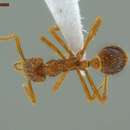en
names in breadcrumbs


Brown and Wilson (1959) summarize the genus as follows: "Widespread in tropics and warm temperate areas. Primarily forest-dwelling; some species occur in grassland and arid scrub. ... Nests mostly in soil and rotting wood; a few species live in arboreal plant cavities in tropical rain forest. Foraging hypogaeic to epigaeic-arboreal. Food: most species are collembolan feeders; a few are polyphagous predators or occasionally feed on sugary substances..."
Members of the genus are all predaceous, with a kinetic mode of attack (Bolton 1999).
borgmeieri is known from few collections. The holotype is from Tapera, Pernambuco, Brazil. I collected a worker in a Winkler sample, sifted litter from the forest floor, in a patch of riparian forest surrounded by pastures, Finca La Pacifica, Guanacaste Province, Costa Rica. The species has also been collected twice at La Selva Biological Station, from forest floor leaf litter.
Brazil, Colombia, Costa Rica. In Costa Rica: Atlantic and northern Pacific lowlands.
Taxonomic history
See also: Bolton, 2000: 531.